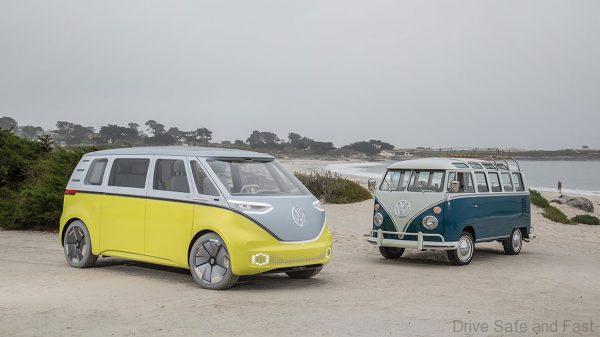Otherwise lovingly known as the VW Kombi or VW Bus.
The iconic Volkswagen Bulli (also known as the Kombi for the passenger version) has sold more than 1.8 million units worldwide. Now the all new model offers an adaptive suspension, plenty of new assistants and a fresh design. Yesterday, March 8th the Bulli celebrated its 70th birthday and brought back memories for many who saw it roll off the assembly line for the first time on the 8th of March 1950.

PRESS RELEASE: Over six generations, this Volkswagen has turned into a true legend. The vision of a Volkswagen transporter had already emerged years before. Unrealized project sketches produced by the Porsche GmbH design office, which was founded in 1931, included a patented proposal for a transporter. Based on a Volkswagen chassis with rear-wheel drive, it anticipated many of the features of the subsequent first model of the series in terms of both design and dimensions.
A sketch of a light commercial vehicle made by the Dutch businessman Ben Pon during a visit at the Wolfsburg factory in April 1947 resuscitated the idea for a transporter. After several prototype experiments on the basis of a Beetle chassis starting in March 1949, the first cars rolled off the assembly line at the Wolfsburg site in March 1950.

The first variant of this VW micro bus offered for sale was the so-called box van. With its large luggage compartment, a high payload and smooth side walls for advertising posters, it achieved the practicality of a transporter for goods production while at the same time serving as a rolling advertisement column for companies and tradespeople. Scarcely a month after the box van came on the market, the so-called “Kombi” followed.









In contrast to its predecessor, the Kombi had windows in the luggage compartment and two rows of seats for passengers. The seats could be easily removed so that the vehicle could serve as a utility van or a passenger car as needed, enabling the car to be used as both a work and a family vehicle. In May 1950, Volkswagen presented a third model, which was sold in Germany as a minibus. The eight-seater was almost identical to the Kombi, but had better interior furnishings and was designed for people who valued roominess and lots of space.
This was followed in June 1951 by a model that was also designed for passenger transport but was far more luxurious than the minibus. Originally offered as a special model in Germany and sold in other countries under the designation “Microbus Deluxe”, the car also became popular under the name “Samba.” The Samba’s most conspicuous feature, besides its large folding top, was the multitude of windows. The luxurious bus had a grand total of 23, whereas a VW Kombi or minibus had to make do with 11 windows. Also typical were the four panoramic windows placed on each side of the roof, in the style of the busses of the day.








Another new characteristic of the vehicle was the generous use of chrome parts. Even the large Volkswagen logo on the front, which was painted white on other models, was chrome-plated here, as were the hubcaps. The Samba’s interior was of high quality and very different from the spartan interior of a box van, for example. The seat upholstery (nine seats in three rows) was made of fabric, and ash trays, handles and hooks for coat hangers were also provided. While the Samba or Deluxe version stood out considerably from the rest of the range with regard to their equipment, the engine was the same. At this time, the plant calculated the maximum speed to be a moderate 80 km/h, corresponding to 3,300 rpm.
As a delivery van, passenger transporter, special vehicle or camper van, the models of the VW micro bus series also stood for newly acquired freedom and wanderlust in the post-war era. Simply driving wherever you wanted to go. With the VW micro bus, a weekend trip to the beach or a family picnic in the countryside signified a new way of life. The VW micro bus thus mutated into a status symbol and an expression of individuality. This was also reflected in the loving furnishing of the cars, with personal accessories such as self-crocheted tablecloths. Some people even traveled around the world in their VW micro bus. The VW micro bus, together with its little brother, the Beetle, therefore became a symbol of the German economic miracle. In North America, the VW micro bus had an extra special significance. In the 1960s, the camper van with its appealing face became the preferred vehicle for hippies and the protest culture of 1968.
The last model of the Volkswagen Kombi rolled out of the factory in 2013 and some 6 million of this boxy, breadbox looking vehicle were built with air-cooled engines and supplied worldwide.
Seventy years after the birth of the first Volkswagen Transporter, the VW micro bus has matured into a true classic car icon. Used vehicles still reach top prices on the used market today. An unrestored running unit will have a sticker price of between RM40,000 and RM60,000 and a fully restored unit will be asking from RM90,000 to a high RM160,000 for an immaculate fully restored ‘bus’.







The combination of unmistakable design, reliability and durability will also shape the future of the VW micro bus.

The Bulli takes the trophy for being the world’s longest running van production. The all new electric powered version of the Volkswagen transporter, the ID. BUZZ, arrives in 2022 and it will some how not have the character of the original.



